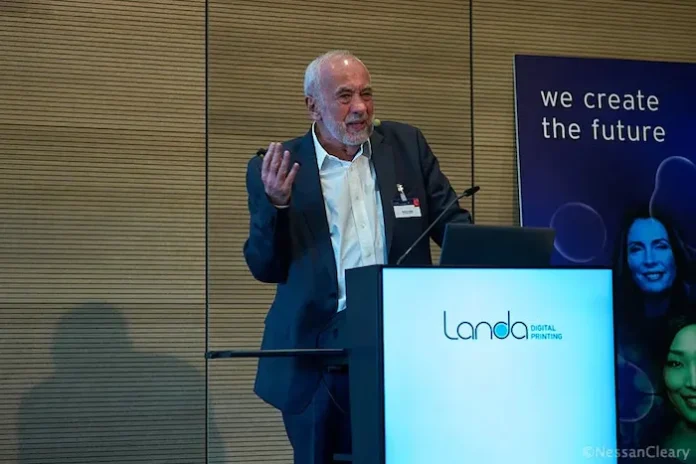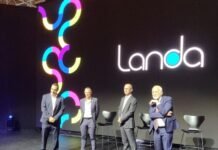As I noted in the first half of this story, Landa Digital Print has filed with an Israeli debt settlement court, triggering much speculation on the company’s future. The court process freezes Landa’s day to day activities and gives the company two weeks to come up with a new plan, which Landa has already done.
I believe the court will be holding a hearing later this week, and since Israeli press reports from Sunday have indicated that the relevant department of the Official Receiver supports this plan, it’s reasonable to assume that it will be approved this week. However, although a lawyer representing over 200 employees has also stated support for the plan, another lawyer representing a further 25 staff has opposed the plan.
The court’s priority is to help the company restructure and ultimately to survive. So if the court accepts the management plan, it would then give the company two months to negotiate a sale or find new investors. Any new arrangements will have to be approved by the court.
But first, let’s take a look at who actually owns Landa Digital Print, or LDP. It is not listed so is a privately owned company. The founder, Benny Landa, is the company’s largest single shareholder, owning 36.7%. Landa personally invested US$ 220 million when the company launched but then had to sell equity within the company to secure further funding.
The main investor has been the German billionaire Susanne Klatten, whose Altana chemicals group holds 28.9%. She also founded and owned outright the SKion investment company which holds 16.4% (and which actually owns Altana). Taken together, that means that Klatten actually controlled the largest interest in the company at 45.3%. However, last year Klatten split the SKion company between her three children, Felix, Alexander and Johanna, who may have different priorities from their mother. Klatten herself comes from the Quandt family so, along with her brother Stefan, she also inherited a 45% stake in BMW.

A further 10% is held by Winder Investment. This is a Singapore-based shell fund, which is controlled by the Haldor Foundation in Liechtenstein, which itself is owned by Kirsten, Finn and Jorn Rausing. They control the Swedish Tetra Laval food carton business that was founded by their grandfather so have an obvious interest in investing in packaging-related technologies.
Landa Labs, Benny Landa’s holding company, owns a further 4.6% and the company’s employees hold 3.1%.
Debts and assets
The company is said to have debts of around NIS 1.7 billion, roughly US$ 516 million. There are different reports in the Israeli media on the make up of this debt, but I have been told that this includes NIS 1.3 billion, around US$ 390, in the form of convertible loans from the shareholders, mostly Altana and SKion. These are secured debts and could even be turned into equity. There is roughly a further NIS 33 million, or US$ 10 million, owed to Israeli banks.
In addition, there is around NIS 300 million, or roughly US$ 90 million, much of which relates to subsystems for presses ordered and not yet delivered. These are therefore balance sheet liabilities, but since they weren’t delivered, they hadn’t been invoiced.
Then there are parts or services that have been delivered in the last 30-60 days, including rent but which were caught up in the normal payment cycle and have now been frozen by the stay of proceedings. These current liabilities are around NIS 80 million, or $23 million. There is some liability towards employees, such as for accumulated holidays though the salaries were paid on the Friday before the insolvency filing.
Against this, the company is said to have assets of around US$ 110 million. This includes roughly US$ 5 million in cash, US$ 50 million in inventory and a further US$ 50-55 million in outstanding payments from customers. The main asset is the intellectual property but it’s difficult to put a figure to that. I have been told that LDP owns all the relevant IP, including those patents that originated from within Landa Labs, and that no one else, such as Altana, owns IP relating to Nanographic printing. Nonetheless, most analysts suggest the IP is worth around US$ 100 million, possibly up to US$ 200 million, though Landa is not in a strong bargaining position.
There has been little mention so far of the customers, some of whom will have been hit very hard by this situation. They are heavily dependent on Landa for the Nano-ink and other consumables such as the transfer belt, which are subject to Landa’s patents so there are no other suppliers. As with all presses, they will also require parts and routine servicing. They will only be able to fulfill orders for so long as they have supplies and won’t be able to take on new work until the situation is clarified, which will undoubtedly cost them some lost business. On the other hand, a relatively large installed base of users might tempt potential investors
One other casualty, which has not featured heavily in the coverage so far, is Komori, which had partnered with Landa. Komori supplied Landa with the media loading and transport system, along with the chassis, and as such is one of the unsecured creditors.
But Komori also depended on Landa to supply the inkjet units for its own NS40 B1 nanographic press. I believe that Komori has shipped at least four of these, with two in Japan, one each in the US and in China, and possibly another in China. So Komori now has an immediate problem in servicing these customers.
That’s a lot less than the 50 machines that Landa installed, largely because Komori took longer to finalise its version. In Komori’s view, the registration was not accurate enough to satisfy its Japanese customers and so Komori further developed the registration system on the NS40 to improve the image quality. Nonetheless, without Landa there is no future for the NS40 either.

For these reasons, Komori would be the most obvious company to take over Landa but Komori does not appear to have the necessary funding. My understanding is that Komori is not optimistic that anyone will acquire the company as a going concern. Komori does have another option for inkjet, having developed its own B2 inkjet press, the J-throne 29 that was shown at Drupa. The design allows for this to be further developed to take B1 sheets.
Recent restructuring
Landa, along with many Israeli companies, has suffered some difficulties relating to the ongoing conflicts that the country has been embroiled in since it was attacked by the Hamas terrorist group in October 2023. There have been missile strikes from Iran, disruption to shipping due to attacks from the Houthi group in Yemen and around 25 percent of Landa’s Israeli workforce has been called up for extended reserve duty. All this is bound to have had a considerable impact on the business including the logistics of getting parts in and presses out.
All the presses were built at the Landa factory in Rehovot, just south of Tel Aviv, Israel. Komori delivered its press chassis to Landa, which then integrated its inkjet module on top. The complete press was then shipped to the customer site. However, earlier this year LDP switched to a new approach, with Komori sending its chassis direct to the customer site. That enabled LDP to add the nanographic unit, completing the press on site, and commissioning it there and then. This would have taken a lot of stress off the factory in Israel. However, my understanding is that although Komori was preparing to follow through on this, it has not yet delivered the first chassis direct to a customer site.
Last month it was reported that Landa had laid off 100 staff as part of a restructuring plan. However I’ve been told that the true figure at that time was closer to half of the 500 staff, mainly in Israel itself. At this point, the board put together a plan on how to reach profitability. It’s been reported that this would have required a further $300 million to break even in 2030. A source from within Landa, that I’m choosing not to name, disputes this, telling me: “The plan presented to and approved by the board earlier this year got to operational cash breakeven and operating profit breakeven much sooner.” It seems most likely that the board were targeting a Drupa 2028 timeframe. It has also been suggested to me that this plan called for much less than the reported US$ 300 million.
Nonetheless, the investors refused to inject any more money into the company. There has been some suggestion in the Israeli press that this was in response to the ongoing conflicts and in particular the very high death rate amongst the civilian Palestinian population in Gaza. But it’s just as likely that the investors had simply run out of patience and opted to cut their losses.
The investors were after all very well placed to understand exactly what stage Landa had reached and to evaluate how much more cash would be required. Also, I don’t think we can underestimate the change of ownership within the Klatten family of SKion, which is the lead investor in Landa. In any case, they clearly lost faith in LDP and did not believe that a few more years and another few hundred million dollars would be enough to deliver on the original promise of a digital system that could genuinely rival offset, with the level of installations and profits that would have flowed from that.
That begs the question of who else might invest in LDP. In researching this story I’ve reached out to people inside Landa, its partners and its rivals and not one of them believe that a white knight is going to come forward and save the company as a going concern. There are two fundamental problems. Firstly, there are the debts that Landa has accrued and the large capital investment that is still required to turn it into a truly profitable company, which could easily swallow another US$ 1 billion.
On top of this, everybody in the running already has a digital printing technology, and would most likely see a better return for that sort of money from concentrating on further developing their existing IP. Everyone is struggling with the same fundamental issue – how to reduce the running costs to compete against offset presses. If Landa had the answers to this then the company wouldn’t be in its current situation.

So it’s most likely that potential suitors will just look to cherry-pick the IP portfolio. Of the companies that are said to have taken a look at the data vault so far, HP already has two proven digital technologies in the form of Indigo and PageWide and a number of B1 presses in the market. Similarly, Agfa also has its Speedset B1 packaging press. Xerox has also been mentioned but I can’t see Xerox being in a rush to get back into commercial inkjet printing, plus it’s still managing its Lexmark acquisition.
There has been some suggestion that the appointment of a Japanese bank, Nomura, to find a buyer might indicate a preference for an Asian company. Of these, Fujifilm is perhaps the most obvious but Fujifilm has already carried out its own R&D into a similar inkjet offset system and has filed patents that are similar to those that Landa holds. My understanding is that Fujifilm has previously determined from its own research that there was no commercial future for such an approach. Nonetheless, Fujifilm is bound to take a look to see if there’s anything that it missed. Fujifilm, or at least its Dimatix subsidiary, is also likely to be amongst the unsecured creditors as Landa’s printhead supplier.
Canon might want to look at the Landa patents, but I think that Canon is too conservative to take a risk on anything as wild as acquiring Landa. Besides, Canon already has a B2 commercial inkjet press in development and based on the conversations that I’ve had with various people from Canon, I don’t believe that the company sees a significant market share in B1 inkjet at the moment. The exception is packaging, where Canon already has a B1 inkjet press in development as well as a larger press for corrugated boards. So Canon’s interest is likely to be limited to whether or not some of the Landa patents could speed up this development.
Epson and Brother have also been mentioned as potential candidates but its hard to see either of these having a serious interest, or the ability to make a success out of the Landa technology.
That leaves Koenig and Bauer, which developed its own RotaJet series of inkjet presses, but more recently has concentrated its efforts on a joint venture with Durst. Of the companies currently in the frame, Koenig and Bauer probably has the most to gain from acquiring Landa’s IP. So far Bobst has not been mentioned, but given that Bobst has a significant slice of the packaging press market, it might also be interested, particularly in the W11 webfed press.
There remains also an outside chance that a Chinese company might take the opportunity to acquire the IP for future use though there is a lot of risk involved in Landa and they are generally more conservative. It’s also possible that a private equity investor would be interested in acquiring the company but the investment level is very high and the return period likely to be quite long, with no guarantees, given the level of competition. And of course any private equity firm would ask, why didn’t the SKion investment company continue, given all the information that it had about Landa?

The obvious conclusion to this story is that Landa massively underestimated the cost of developing the nanography presses and overestimated the size of the market. A bigger, better funded organisation, freed from the burden of constantly having to look for more money, would have been better able to evaluate these things more accurately. And yet the nanography presses do work, as proven by the 50 of them that are running plus the four NS40s, and some part of this technology is bound to live on regardless of the legal process currently underway.
You can find the first half of this story, Landa collapses into insolvency, here.
This story was first posted on the Printing and Manufacturing journal on
9th July 2025. Republished by permission.











